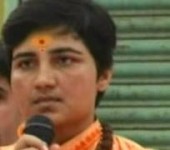Crime and the media

It is fascinating to watch how the Sangh Parivar is reacting to the current investigation into the
The questions that the media has to confront, whether covering
Last month, Chief Justice of India K. G. Balakrishnan also gave a pertinent reminder to the media about its role in reporting crime and on-going investigations. Speaking at a workshop organised by the Bombay High Court on Sunday, October 19 on "Reporting of Court Proceedings by Media", he said, "Privacy of the person must be protected. Sometimes damaging information is revealed during the investigation. It adversely affects people’s right to a fair trial". He also reportedly criticised police officers revealing information to the media during investigation and said that this encroached upon the right to privacy.
The point that has to be debated and considered is not whether the media should report what the police reveals about a crime under investigation but how it should report it. We also need to question whether the police should leak to a few chosen journalists, or publicly release, incremental information on investigations into crimes. Sometimes the information is not just incremental, it is also unsubstantiated and later contradicted by the police. But in the meantime, the individual involved is victim to grievous injustice, judged without a fair trial.
As far as the media is concerned, the norms of reporting on crime, or terror, should not differ. If suspects are picked up for a crime, they are precisely that – suspects. Until a case is made out that will hold in a court of law, we in the media cannot name them as "murderer", "thief", "cheat" or even "terrorist". Regardless of what the police reveal to the public, based on their investigations or confessions of these suspects, the media must qualify what it reports. That is the only guarantee for the innocent amongst these suspects to have any chance of rebuilding their lives if they are proved innocent, or if the police are unable to establish their guilt. These norms have been well established and just because we now live in a more competitive media environment, they surely should not be abandoned. Yet, even a cursory survey of both print and broadcast would reveal how easily some of these norms have slipped or even disappeared altogether. Their absence does nothing to enhance the credibility of the media.
We should be equally disturbed at the way various police units are rushing to the media with information. During the Arushi murder case, the police was shown up clearly to have crossed the line. The media could argue that it had no option but to report what the police said. But it is also evident that some of the media used the police information to dramatise the ghastly murder to increase their viewership. In the process, where was the individual’s right to privacy or a fair trial?
The rash of media briefings, official and unofficial, continues unabated in the terror investigations. Why are they necessary? Do people need to know every detail about on-going investigations or is it more important to investigate and produce credible results? Today, ordinary people are genuinely confused about what really is going on and inevitably, there are questions raised about the credibility, and even efficiency, of the various police forces. This is not the result of some inherent suspicion in the minds of people about the police. It is the consequence of the manner in which the police have exposed themselves by putting out half-baked information into the public domain through the media.
Apart from the terror investigations, media briefings are gradually becoming the norm amongst police in different cities even for minor crimes. For instance, earlier this month, the Mumbai police held a media briefing where they paraded a 10-year-old boy suspected of being responsible for spreading a rumour about people being kidnapped as part of a kidney racket. The boy apparently confessed. His father was also present at the briefing. The juvenile offender was photographed and the police officer gave his name and other details even though this is prohibited under the Juvenile Justice Act.
This particular briefing cannot be dismissed as an aberration, the action of a police officer bitten by the publicity bug. It raises the same questions as in the terror investigations -- is the police using the media because the media feeds off such information or is the media’s aggressive demand for information on crime forcing the police to go public?
Another offshoot of the issue emphasised by the Chief Justice impinges on women who are victims of violence. When the rape of the nun in Kandhamal, Orissa, was first reported, no paper gave away her name or identity. And rightly so. Even when she spoke to some television channels, there was no hint of where she was, or who she was. But in subsequent days, some newspapers tracked down her family, carried photographs of the village where they lived, gave details of the location of the village, quoted her father and brother, giving their full names. In other words, every bit of information short of the name of the victim was reported. (Even if she went public later, the earlier conduct of the media is highly questionable.) Can this be explained away as the inevitable consequence of a competitive media? How does such reporting conform to the Chief Justice’s appeal for the individual’s right to privacy? Should we just conform to the letter of the rule of not revealing the identity of rape victims or do we also have a responsibility to adhere to the spirit that informed that rule?
These are questions that the media must address. We need to seriously interrogate our approach towards crime and justice and ensure that we are not abetting the former and negating the latter.
The writer is an independent journalist based in Mumbai.






